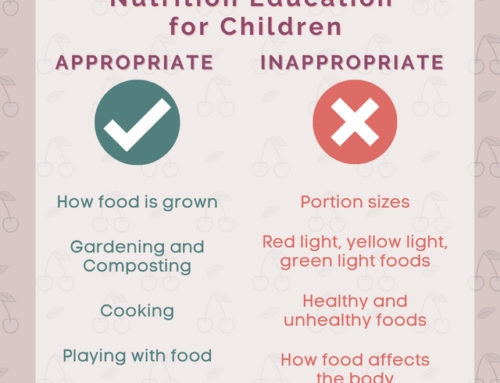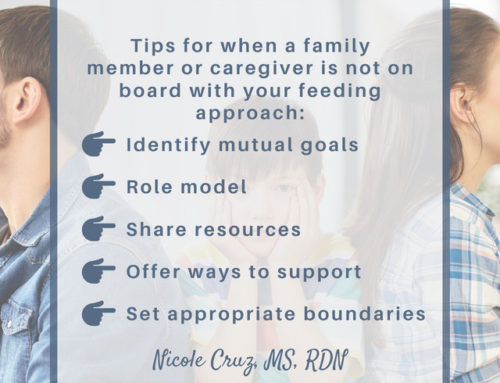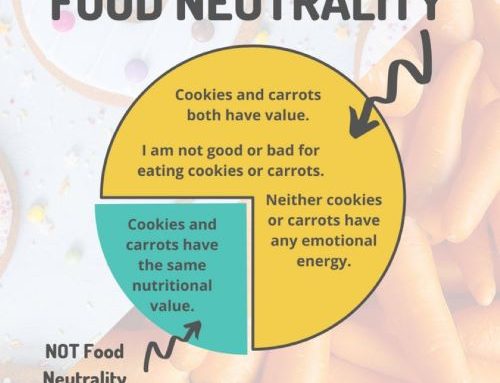Every time my mom watches my kids she says, “They eat so much fruit!” And, “They never stop eating!” She has started bringing fruit to my house when she watches them because she feels bad they go through so much. I know she wants them to be happy, get enough to eat, and to eat what they want. But it begs the question, “Should I let my kid eat what he wants?”
And what I always tell her is, “Mom, just because they ask for something doesn’t mean you have to give it to them.”
Following the Division of Responsibility (DOR), simply making foods available, and being proactive about meals and snacks, all create less stress and more joy… for everyone!
A quick note- the DOR is a philosophy around feeding children developed by Ellyn Satter. It encourages parents to be in charge of the What, When, and Where of food. And children decide how much, and whether or not, they eat (from the food that is made available).
Let me explain a bit more…
Yesterday, my mom was over with my niece and nephew and my kids. Normally she watches them when I’m gone, but because of summer schedules, I was home and we were hanging out with the kiddos all together. When it was lunch time, she started asking all 3 of the older boys, “What do you want for lunch?” My oldest said, “Chicken wings”. I think because we had them the day before for Father’s Day. Well, they were all gone, no leftovers. My nephew said, “I’m not hungry”. And my 4 year old never responded.
So, I gave them a few minutes. They started playing again and I went in and made lunch for everyone: cheese quesadillas, carrots, Ranch dressing, fruit, chips, guacamole, and cookies. When I put the cookies out with the rest of the meal, my mom said, “Well, those will be gone first.”
They all got to choose what they wanted. They ALL ate, including my nephew, who said “I’m not hungry.”
All five of them ate different things. Some ate their entire meal and got more of certain foods. Some didn’t eat parts of their meal, including cookies.
No one was pressured or forced. But they all ate something. Then they continued to play.
Awhile later, my boys said, “I’m hungry,” and I realized it was about snack time. My oldest grabbed a bag of chips from the cupboard, and said, “I want these.” I honestly hadn’t thought about snack yet, so I needed a moment to assess what we had. I asked him to set them on the counter and I would figure out the choices in a minute.
I didn’t say “No chips. We already had chips today.” And I also didn’t open-ended ask, “What do you want for snack?” I needed to look around, see the options, and decide what we had a good amount of for everyone. The decision was crackers with peanut butter and honey and watermelon. I could have put out the chips, but I honestly had just bought them and wasn’t sure if I wanted to use them for something else. And they had chips earlier, which I took into account, but it wasn’t the deciding factor. I also wanted to make sure that I offered something that had enough substance, hence the peanut butter to add some fat and protein.
Some ate, some didn’t. Awhile later my middle one said he was hungry. I referred back to the table. He said, “I don’t want that. I want a banana.”
No problem. You don’t have to eat it. Dinner will be in a bit.”
He asked again. Same conversation. [Mom would have given him the banana.] I could have certainly said, “Sure. You can have a banana and if you are still hungry after that, the peanut butter crackers and watermelon are available.” There are times when I respond to what they want, but in this instance I didn’t have enough bananas for everyone and I had already made a snack that was out. A few minutes later he went over and ate a cracker or two.
Follow the Division of Responsibility
When following the DOR, parents, or caregivers, are responsible for deciding What is available. Not trying to call out my mom, after all she watches my children!! And she’s super awesome! But giving young children open-ended questions about food choices is overwhelming. (If you want to offer choices, and sometime I do, just depends, offer two to three choices, max.) Children don’t know where to begin, and often, they don’t know all of the choices that are available or may just think about things they had recently they liked. They also think concretely and may not consider how to combine foods or put together a complete, sustaining meal or snack. And just because they ask for something doesn’t mean you have to give it to them.
Make Food Available
Making food available and giving them options puts them in charge of listening to their bodies. When my nephew said he wasn’t hungry, that was fine. He didn’t have to eat. But he might have just not wanted to stop playing, or maybe was going to be hungry in a few minutes but didn’t realize yet. As caregivers, we can understand and recognize these patters and time frames and respond by putting food out accordingly.
Be proactive about meals and snacks
Being proactive does not mean having to meal plan and prep everything in advance. When I use the term in relation to feeding, I mean, putting the food out instead of waiting for them to ask for a million different things. Or responding to when they say they are hungry by getting out a variety of food. The opposite might be:
“I want watermelon.” Get up and get watermelon. “I want chips.” Go get chips. “I want a banana.” Now go get a banana.
Being proactive looks like:
“I want watermelon.” –> “Ok. You’re hungry. Let me get out a snack to go with the watermelon.” And now, watermelon and a variety of food is available.
It doesn’t have to elaborate. Like I said, yesterday it was peanut butter and honey on crackers and watermelon. Sometimes it’s crackers, cheese, salami, and fruit. Or yogurt, granola, and fruit. Or veggies, dip, and peanut butter pretzels.
Conclusion
Should I let my kid eat what he wants? Following the DOR, deciding what foods are available, and being proactive in setting up food do not directly cater to exactly what they want every time. But this approach does create less stress and more joy in feeding… for everyone. I appreciate making a snack once and not running back in and out of the kitchen responding to every request. It also comforts me to know that I am providing the opportunity for them to eat what they need and learn to trust their internal signals. (For more on this, read How to Raise an Intuitive Eater,) And best of all, it takes the fighting and pressure away from food. Everyone is happier.








Leave A Comment